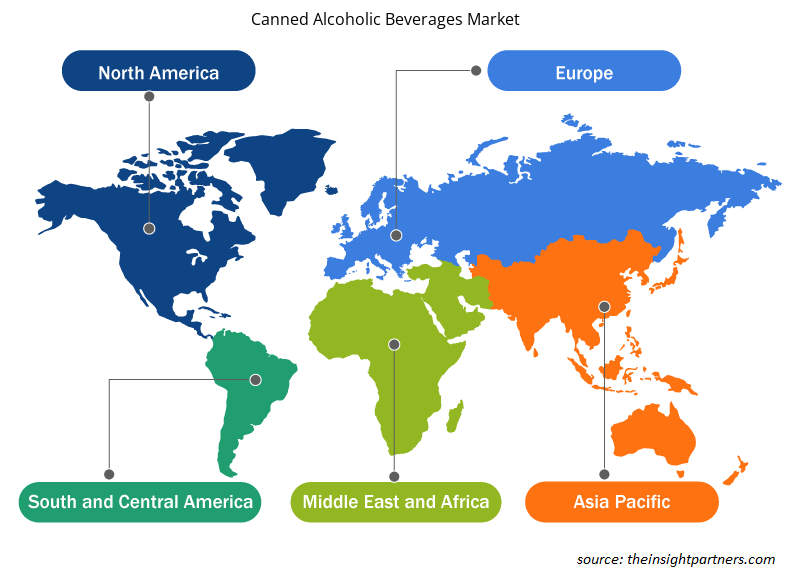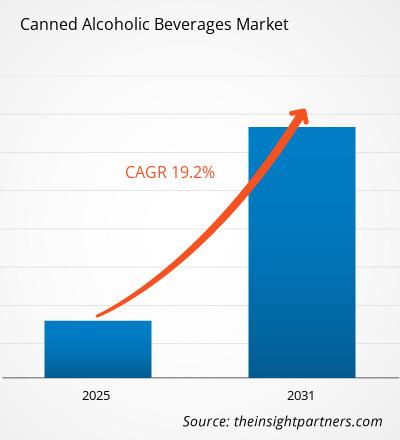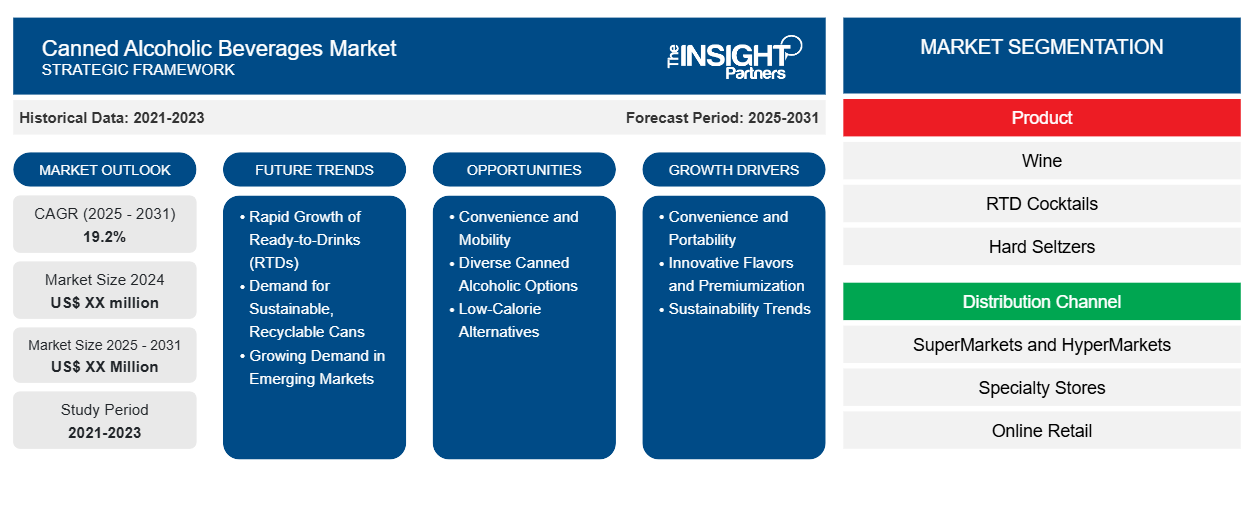Se espera que el mercado de bebidas alcohólicas enlatadas registre una CAGR del 19,2% entre 2023 y 2031, con un tamaño de mercado que se expandirá de US$ XX millones en 2023 a US$ XX millones en 2031.
El informe del mercado de bebidas alcohólicas enlatadas cubre el análisis por producto (vino, cócteles RTD, refrescos carbonatados, otros); canal de distribución (supermercados e hipermercados, tiendas especializadas, venta minorista en línea, otros). El análisis global se desglosa aún más a nivel regional y por países principales. El informe ofrece el valor en USD para el análisis y los segmentos anteriores.
Propósito del Informe
El informe Canned Alcoholic Beverages Market de The Insight Partners tiene como objetivo describir el panorama actual y el crecimiento futuro, los principales factores impulsores, los desafíos y las oportunidades. Esto proporcionará información a diversas partes interesadas del negocio, como:
- Proveedores/fabricantes de tecnología: Para comprender la dinámica cambiante del mercado y conocer las oportunidades potenciales de crecimiento, lo que les permitirá tomar decisiones estratégicas informadas.
- Inversionistas: Realizar un análisis exhaustivo de tendencias sobre la tasa de crecimiento del mercado, las proyecciones financieras del mercado y las oportunidades que existen en toda la cadena de valor.
- Órganos reguladores: Regular las políticas y vigilar las actividades del mercado con el objetivo de minimizar los abusos, preservar la confianza de los inversores y defender la integridad y la estabilidad del mercado.
Segmentación del mercado de bebidas alcohólicas enlatadas
Producto
- Vino
- Cócteles RTD
- Seltzer duro
Canal de distribución
- Supermercados e Hipermercados
- Tiendas especializadas
- Venta minorista en línea
Personalice este informe según sus necesidades
Obtendrá personalización en cualquier informe, sin cargo, incluidas partes de este informe o análisis a nivel de país, paquete de datos de Excel, así como también grandes ofertas y descuentos para empresas emergentes y universidades.
- Obtenga las principales tendencias clave del mercado de este informe.Esta muestra GRATUITA incluirá análisis de datos, desde tendencias del mercado hasta estimaciones y pronósticos.
Factores impulsores del crecimiento del mercado de bebidas alcohólicas enlatadas
- Comodidad y portabilidad: la demanda mundial de bebidas alcohólicas listas para beber, que se puedan transportar fácilmente, está aumentando. Este cambio en el estilo de vida y la preferencia de los consumidores hacia opciones de consumo más rápido estimulan el crecimiento del mercado.
- Sabores innovadores y premiumización: los fabricantes ofrecen sabores novedosos y mezclas premium en función de los cambios en las preferencias de los consumidores. La diferenciación de productos impulsa las tendencias del mercado y el análisis competitivo para atraer a más consumidores.
- Tendencias de sostenibilidad: la creciente conciencia de los consumidores sobre el medio ambiente está contribuyendo a impulsar el uso de bebidas enlatadas reciclables. El enfoque en la reducción de los residuos plásticos genera un aumento del tamaño del mercado y los productores comienzan a crear sustitutos respetuosos con el medio ambiente.
Tendencias futuras del mercado de bebidas alcohólicas enlatadas
- Crecimiento rápido de las bebidas listas para beber (RTD): las bebidas listas para beber están experimentando un rápido crecimiento debido a la alta demanda y la facilidad de consumo. Los actores clave se están centrando en nuevos sabores y envases ecológicos como parte de sus estrategias de mercado. Los productos premium están en alza, aunque las cuestiones regulatorias en torno al etiquetado y la comercialización de bebidas alcohólicas pueden limitar la expansión del mercado.
- Demanda de latas sostenibles y reciclables: la demanda de los consumidores de latas sostenibles y reciclables está dando forma a la dinámica del mercado. Las empresas se centran en reducir su huella de carbono y adoptar tecnologías ecológicas. Las estrategias enfatizan las iniciativas ecológicas al tiempo que garantizan el cumplimiento de las regulaciones. El análisis FODA destaca las oportunidades para atraer a los consumidores con conciencia ecológica, pero los costos de sostenibilidad podrían afectar la rentabilidad y las previsiones del mercado.
- Demanda creciente en mercados emergentes: el aumento de los ingresos disponibles y los cambios en los estilos de vida en los mercados emergentes están impulsando la demanda de bebidas alcohólicas enlatadas. Las estrategias de localización, especialmente en términos de sabor y marketing, son cruciales para el éxito en el mercado. El análisis FODA identifica los riesgos derivados de los cambios regulatorios y la saturación del mercado, pero existen oportunidades a través de innovaciones específicas para expandir las líneas de productos y captar nuevos segmentos de consumidores.
Oportunidades de mercado para bebidas alcohólicas enlatadas
- Conveniencia y movilidad: Las empresas pueden aprovechar la creciente popularidad de las bebidas enlatadas y listas para beber concentrándose en la conveniencia, la portabilidad, los envases innovadores y los ingredientes de alta calidad, especialmente en los mercados de América del Norte y el mundo.
- Diversas opciones de bebidas alcohólicas enlatadas: con una amplia gama de opciones únicas y diversas de bebidas alcohólicas enlatadas, como cócteles artesanales, las empresas pueden aprovechar las preferencias cambiantes de los consumidores y expandir su presencia en el mercado en varias geografías.
- Alternativas bajas en calorías: la introducción de versiones bajas en calorías de bebidas alcohólicas enlatadas permite a las empresas capitalizar la tendencia del bienestar, ampliando su atractivo en el mercado y mejorando su relevancia para los consumidores preocupados por la salud.
Perspectivas regionales del mercado de bebidas alcohólicas enlatadas
Los analistas de Insight Partners explicaron en detalle las tendencias y los factores regionales que influyen en el mercado de bebidas alcohólicas enlatadas durante el período de pronóstico. Esta sección también analiza los segmentos y la geografía del mercado de bebidas alcohólicas enlatadas en América del Norte, Europa, Asia Pacífico, Medio Oriente y África, y América del Sur y Central.

- Obtenga datos regionales específicos para el mercado de bebidas alcohólicas enlatadas
Alcance del informe de mercado de bebidas alcohólicas enlatadas
| Atributo del informe | Detalles |
|---|---|
| Tamaño del mercado en 2023 | XX millones de dólares estadounidenses |
| Tamaño del mercado en 2031 | US$ XX millones |
| CAGR global (2023 - 2031)CAGR (2023 - 2031) | 19,2% |
| Datos históricos | 2021-2022 |
| Período de pronóstico | 2024-2031 |
| Segmentos cubiertos | Por producto
|
| Regiones y países cubiertos | América del norte
|
| Líderes del mercado y perfiles de empresas clave |
|
Densidad de actores del mercado de bebidas alcohólicas enlatadas: comprensión de su impacto en la dinámica empresarial
El mercado de bebidas alcohólicas enlatadas está creciendo rápidamente, impulsado por la creciente demanda de los usuarios finales debido a factores como la evolución de las preferencias de los consumidores, los avances tecnológicos y una mayor conciencia de los beneficios del producto. A medida que aumenta la demanda, las empresas amplían sus ofertas, innovan para satisfacer las necesidades de los consumidores y aprovechan las tendencias emergentes, lo que impulsa aún más el crecimiento del mercado.
La densidad de actores del mercado se refiere a la distribución de las empresas o firmas que operan dentro de un mercado o industria en particular. Indica cuántos competidores (actores del mercado) están presentes en un espacio de mercado determinado en relación con su tamaño o valor total de mercado.
Las principales empresas que operan en el mercado de bebidas alcohólicas enlatadas son:
- PepsiCo
- La Compañía Coca-Cola
- Cafetera Keurig Dr Pepper Inc.
- Toro rojo
- Del Monte Fresco
Descargo de responsabilidad : Las empresas enumeradas anteriormente no están clasificadas en ningún orden particular.

- Obtenga una descripción general de los principales actores clave del mercado de bebidas alcohólicas enlatadas
Puntos de venta clave
- Cobertura integral: el informe cubre de manera integral el análisis de productos, servicios, tipos y usuarios finales del mercado de bebidas alcohólicas enlatadas, proporcionando un panorama holístico.
- Análisis de expertos: el informe se compila sobre la base de un profundo conocimiento de expertos y analistas de la industria.
- Información actualizada: El informe asegura relevancia comercial debido a su cobertura de información reciente y tendencias de datos.
- Opciones de personalización: este informe se puede personalizar para satisfacer los requisitos específicos del cliente y adaptarse adecuadamente a las estrategias comerciales.
Por lo tanto, el informe de investigación sobre el mercado de bebidas alcohólicas enlatadas puede ayudar a abrir camino para descifrar y comprender el escenario de la industria y las perspectivas de crecimiento. Si bien puede haber algunas preocupaciones válidas, los beneficios generales de este informe tienden a superar las desventajas.
- Análisis histórico (2 años), año base, pronóstico (7 años) con CAGR
- Análisis PEST y FODA
- Tamaño del mercado, valor/volumen: global, regional y nacional
- Industria y panorama competitivo
- Conjunto de datos de Excel
Informes recientes
Informes relacionados
Testimonios
Razón para comprar
- Toma de decisiones informada
- Comprensión de la dinámica del mercado
- Análisis competitivo
- Información sobre clientes
- Pronósticos del mercado
- Mitigación de riesgos
- Planificación estratégica
- Justificación de la inversión
- Identificación de mercados emergentes
- Mejora de las estrategias de marketing
- Impulso de la eficiencia operativa
- Alineación con las tendencias regulatorias





















 Obtenga una muestra gratuita para - Mercado de bebidas alcohólicas enlatadas
Obtenga una muestra gratuita para - Mercado de bebidas alcohólicas enlatadas